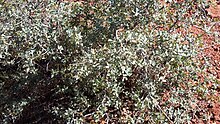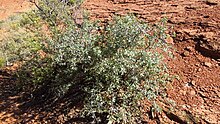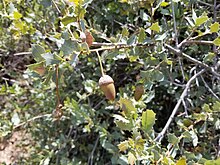Quercus turbinella
| Quercus turbinella | |
|---|---|

| |

| |
| Scientific classification | |
| Kingdom: | Plantae |
| Clade: | Tracheophytes |
| Clade: | Angiosperms |
| Clade: | Eudicots |
| Clade: | Rosids |
| Order: | Fagales |
| Family: | Fagaceae |
| Genus: | Quercus |
| Subgenus: | Quercus subg. Quercus |
| Section: | Quercus sect. Quercus |
| Species: | Q. turbinella
|
| Binomial name | |
| Quercus turbinella | |

| |
| Natural range | |
| Synonyms[2] | |
| |

Quercus turbinella is a North American species of oak known by the common names shrub oak, turbinella oak, shrub live oak, and gray oak.[3][4][5] It is native to Arizona, California, New Mexico, Utah, Colorado, and Nevada in the western United States.[3] It also occurs in northern Mexico.[6]

Distribution[]
Quercus turbinella has been found in Arizona, New Mexico, Colorado, Utah, Nevada, southern California, and western Texas, Baja California, .[7][4] In California it occurs in the New York mountains and a few eastern California desert ranges. The populations on the desert mountains in the western Mojave desert and the inner coastal ranges are now considered Quercus john-tuckeri.[8] [9] It grows in woodland, chaparral, forest, and other habitat. It is most common in chaparral habitat in central Arizona,[5] through the transition zone of the Mogollon Rim–White Mountains, but also southeast Arizona in the Madrean Sky Island mountain ranges of sky islands.[10]
Description[]
Quercus turbinella is a shrub growing 2–5 meters (6.6–16.4 ft) in height but sometimes becoming treelike and exceeding 6 meters (20 feet). The branches are gray or brown, the twigs often coated in short woolly fibers when young and becoming scaly with age. The thick, leathery evergreen leaves are up to 3 centimeters (1.2 inches) long by 2 cm (0.79 in) wide and are edged with large, spine-tipped teeth. They are gray-green to yellowish in color and waxy in texture on the upper surfaces, and yellowish and hairy or woolly and glandular on the lower surfaces. The males catkins are yellowish-green and the female flowers are in short spikes in the leaf axils, appearing at the same time as the new growth of leaves. The fruit is a yellowish brown acorn up to two centimeters long with a shallow warty cup about a centimeter wide.[6] This oak reproduces sexually via its acorns if there is enough moisture present, but more often it reproduces vegetatively by sprouting from its rhizome and root crown.[5][3]
Quercus turbinella easily hybridizes with other oak species, including Quercus gambelii, Quercus havardii, Quercus arizonica, Q. grisea.[5] Many species of animals use it for food, with wild and domesticated ungulates browsing the foliage and many birds and mammals eating the acorns.[5] Animals also use the shrub as cover, and mountain lions hide their kills in the thickets.[5]
See also[]
References[]
| Wikimedia Commons has media related to Quercus turbinella. |
- ^ "Quercus turbinella". IUCN Red List of Threatened Species. 2015. 2015. Retrieved 5 November 2017.
data
- ^ "Quercus turbinella Greene". World Checklist of Selected Plant Families (WCSP). Royal Botanic Gardens, Kew – via The Plant List.
- ^ Jump up to: a b c Nixon, Kevin C. (1997). "Quercus turbinella". In Flora of North America Editorial Committee (ed.). Flora of North America North of Mexico (FNA). 3. New York and Oxford – via eFloras.org, Missouri Botanical Garden, St. Louis, MO & Harvard University Herbaria, Cambridge, MA.
- ^ Jump up to: a b "Quercus turbinella". Calflora: Information on California plants for education, research and conservation. Berkeley, California: The Calflora Database – via www.calflora.org.
- ^ Jump up to: a b c d e f Tirmenstein, D. (1999). "Quercus turbinella". Fire Effects Information System (FEIS). US Department of Agriculture (USDA), Forest Service (USFS), Rocky Mountain Research Station, Fire Sciences Laboratory – via https://www.feis-crs.org/feis/.
- ^ Jump up to: a b Virginia Tech: Shrub live oak Archived May 9, 2011, at the Wayback Machine
- ^ "Quercus turbinella". County-level distribution map from the North American Plant Atlas (NAPA). Biota of North America Program (BONAP). 2014.
- ^ Calflora
- ^ SEINet, Southwestern Biodiversity, Arizona chapter photos, description, interactive distribution map
- ^ Little Jr., Elbert L. (1976). "Map 147, Quercus turbinella". Atlas of United States Trees. 3 (Minor Western Hardwoods). US Government Printing Office. LCCN 79-653298. OCLC 4053799.
External links[]
- Jepson eFlora, The Jepson Herbarium, University of California, Berkeley
- Flora of North America; flora of North America RangeMap
- Quercus turbinella in the CalPhotos photo database, University of California, Berkeley
- IUCN Red List least concern species
- Quercus
- Trees of Northwestern Mexico
- Trees of the Southwestern United States
- Trees of the South-Central United States
- Flora of the California desert regions
- Flora of the Sonoran Deserts
- Natural history of the Colorado Desert
- Natural history of the Mojave Desert
- Plants described in 1889
